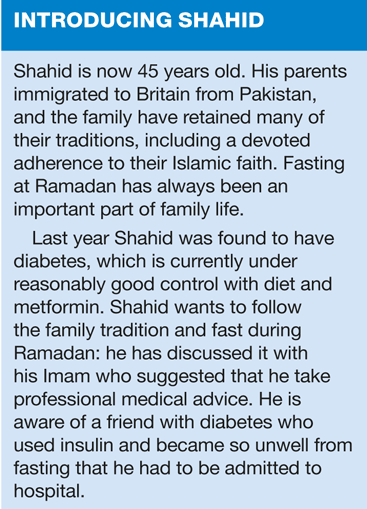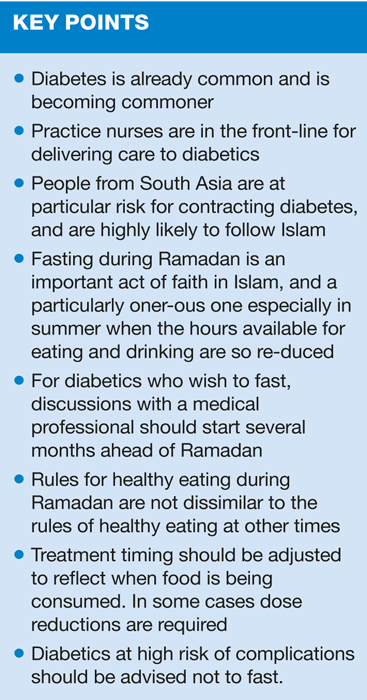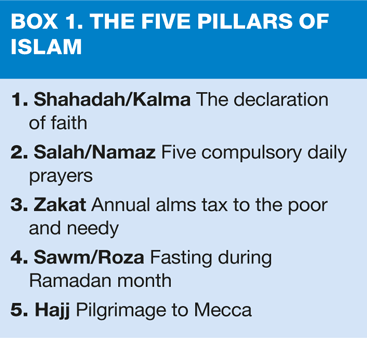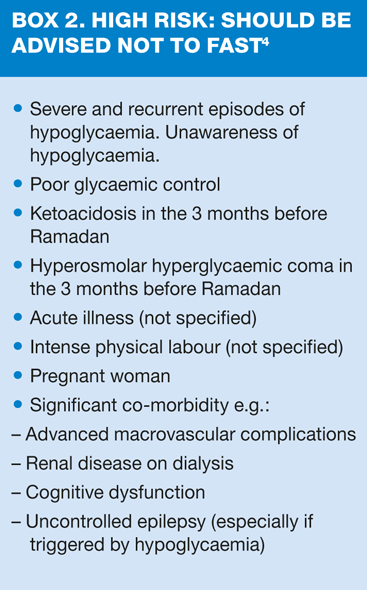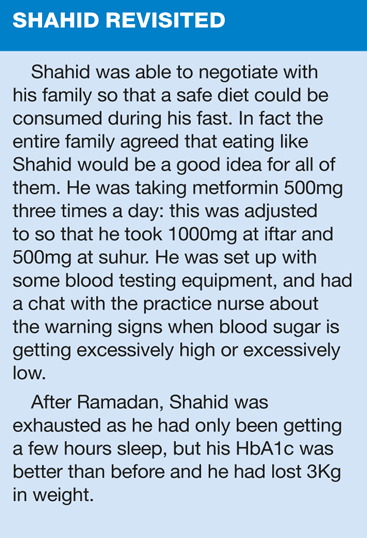Preparing Muslim patients with diabetes for Ramadan
Dr Ed Warren FRCGP
Dr Ed Warren FRCGP
GP in Sheffield, Trainer, Barnsley VTS
The Islamic holy month of Ramadan is not for several weeks yet - 20 July until 18 August - but for people with diabetes who wish to fast, discussions with their healthcare team should start several months ahead
In their analysis of prevalence, Diabetes UK estimates that there are 2.9 million people in Britain with diagnosed diabetes and nearly another million with diabetes as yet not diagnosed.1 This means that about one in 20 of the UK population has diabetes. In the past diabetes was very much a 'hospital' condition, with all diabetics trailing off to an outpatient clinic for their care. Then three things changed:
1. The number of people with diabetes began to rise considerably, a rise which shows no sign of abating. It is estimated that by 2025 there will be 5 million people in the UK with diabetes.1
2. It was found that looking after people with diabetes in primary care, as long as the care was organised, was every bit as effective as the care that the hospitals were managing,2 and that moreover 85% of patients preferred this approach.
3. General practitioners found a pride in their ability to cope with chronic diseases in the community, a trend that predates by decades the provisions of the Quality and Outcomes Framework. Primary care of diabetes came to be regarded as an 'index case' - a surrogate measure of how a general practice managed chronic diseases generally. So diabetes is now overwhelmingly a primary care condition. But for the care to be effective it has to be organised.
So where does a practice look for a team of professionals who can be relied upon to deliver systematic education and care to a group of patients whose burden of morbidity and mortality is so large?1 Step forward the Practice Nurse. Diabetes in the UK is not only mainly a primary care condition; it is a Practice Nurse condition.
The risk of contracting diabetes depends on a number of factors including ethnicity. People who have immigrated to the UK from South Asia are between two and six times more likely to develop type 2 diabetes when compared with the total population. In addition, as far as type 2 diabetes is concerned, people from South Asia contract the illness at an average age of 25, compared with 40 for the general population.1 So the South Asian community get diabetes more commonly and at an earlier age. The Muslim Council for Britain estimates that there are about 1.6 million Muslims living in the UK, of whom 1.2 million are of South Asian origin.3 Immigration from South Asia has not been even across the UK, and so if you are a practice nurse in Bradford or Leicester, there is a good chance that you will be very familiar with a community of Muslims who are also diabetic.
Fasting for the month of Ramadan is one of the Five Pillars of Islam (see Box 1). This requires the faithful not to eat or drink during the hours between sunrise and sunset. Although the Qur'an exempts the sick from the duty to fast (2:185) many people with diabetes do not regard themselves as being sick. Community surveys suggest that among Muslims 43% of people with type 1 diabetes and 79% of those with type 2 diabetes fast during Ramadan.4 The dates of Ramadan follow a lunar calendar and the start gets about 10 days earlier each year: for the next decade Ramadan falls during the summer in the northern hemisphere when the hours between sunset and sunrise when eating and drinking is permitted may be as few as 4 or 5. In those patients with type 2 diabetes who undertake the Ramadan fast, there is a five-fold increase in the risk of severe hyperglycaemia, and a more than seven-fold increased risk of significant hypoglycaemia (from 0.4 to 3 events per 100 people per month).4
RISK ASSESSMENT
Most Muslim religious authorities accept that if a person is advised by a trusted health professional (such as a nurse or a doctor) that fasting would be harmful to health, then that person is exempted.5 So it is not uncommon for the trusted Practice Nurse to be called upon for advice. Such advice must take account both of the practicalities of the diabetes and also the sensitive nature of the issues involved. The evidence base for advice is a little thin,4 rather surprising given the fine and ancient traditions of medicine within the Arab world. It is suggested the risk of fasting in diabetes can be stratified into 3 levels:4
Low risk
Well controlled diabetes and otherwise good health (i.e. no complications) using diet alone, or only one medicine such as metformin, a dipeptidyl peptidase-4 inhibitor (DPP-4) - drugs ending in gliptin, e.g. sitagliptin, or a thiazolidinedione - ending in glitazone e.g. pioglitazone. These people can fast without healthcare advice. Fasting imposes a reduction of calorie intake, which is particularly significant if the hours of darkness are few: people with diabetes may well emerge from their fast slimmer and with better glycaemic control.
High risk
This group are at significant risk from hypoglycaemia and hyperglycaemia and should be advised not to fast.4 It will be seen that some of these criteria are a bit loose so that judgement is still required. (Box 2). An 'acute illness' could be almost anything: this would certainly include a serious illness (such as myocardial infarction) but also other short-term problems particularly if they cause vomiting, diarrhoea or significant pyrexia. Adequate hydration is especially important. Some people will decide to fast despite your advice. In these cases education is even more important, especially information about self-testing and recognising when problems are imminent.
Medium risk
This is the tricky group as personalised advice is required, involving education and treatment adjustments. People with diabetes intending to fast should preferably talk to their medical advisors several months before the fast commences. Patients to be considered at medium risk are those who are well controlled on sulfonylureas (drugs ending in -ide e.g. gliclazide), insulin, or short-acting insulin secretologues (drugs ending in -glinide e.g. nateglinide), or combinations of the above.
EDUCATION4
These suggestions are luckily not too dissimilar to the recommendations when not fasting, so should not require major lifestyle adjustments. Plans should be made well in advance so that implementation fits around the other traditions in force during Ramadan.
Meal planning
- Follow a 'healthy, balanced' diet. The Diabetes UK website contains extensive ad-vice about eating in diabetes in their 'Ten Steps to Eating Well' plan. It is the sort of advice for good health that would be applicable to people generally whether or not they have diabetes. There are some anomalies as far as Ramadan is concerned: for example diabetics are advised to eat 3 meals a day.
- Before and after fasting, consume slow-energy-release foods (e.g. wheat, semolina, beans, rice), and reduce saturated fats by avoiding ghee, samosas, pakoras.
- Consume only small amounts monounsaturated fats (olive oil, rapeseed oil) when cooking.
- Include high fibre foods e.g. wholegrain cereals, granary bread, brown rice, pulses, beans, fruit, salads, vegetables.
Exercise
- Take regular light to moderate exercise
- Avoid vigorous exercise if on insulin or sulfonylurea
- Continue usual activities, especially in non-fasting times
- Tarawaih prayers (the series of prayers after the sunset meal) constitute light exercise as they involve standing, bowing, prostrating and sitting.
Blood glucose monitoring
- All who fast should have the means to self-monitor. Generally people with type 2 diabetes do not get any benefit (and may even be harmed) by glucose self-testing,6 but fasting imposes particular physiological strains, and hypoglycaemia needs to be recognised early if it is to be dealt with avoiding undue alarms.
- Check blood sugar when the subject is unwell or when there is imminent hypoglycaemia (fast should be broken)
Recognising problems
- Discussion of warning signs of dehydration, hyperglycaemia and hypoglycaemia (the fast should be broken).
Type 2 diabetes
Usually during Ramadan two meals are taken: iftar (after sunset) is usually the main meal, and suhur (before dawn). After Ramadan, early assessment is needed to ensure that glycaemic control has been restored.
Metformin
Split the dose so that two thirds are taken at iftar and one third at suhur. If using modified-release metformin, then take the full dose at iftar.
Sulfanylureas
Once daily doses - take at iftar. Twice daily - reduce total dose by 25% and then divide the new dose so that 50% of the non-fasting dose is taken at iftar, and 25% at suhur. If there have been previous problems with hypoglycaemia, then using a gliptin instead may be worth trying: any such change should be initiated well before the month of Ramadan.
Gliptins, glitazones, glinides
No dose adjustment is needed, but the medications should be taken with meals.
Insulin
If using once a day, use at iftar and reduce dose by 20%. If twice a day, normal dose at iftar, dose reduced by 30% at suhur.
TYPE 1 DIABETES
The evidence for this group is particularly scant. It would be wise to consult either an approachable consultant or your local community diabetes nurse for advice.
CONCLUSION
Fasting for Ramadan, especially during summer, is a pretty tough ask and can only attract respect. For most people with diabetes, fasting can be undertaken safely with only a few adjustments to eating and medication habits. However some people with diabetes are at particular risk, and should be advised not to fast. The Qur'an says that adherents should not put themselves in danger by fasting.
REFERENCES
1. Diabetes UK. Diabetes in the UK 2011/2012: Key statistics on diabetes. http://www.diabetes.org.uk/Documents/Reports/Diabetes-in-the-UK-2011-12.pdf
2.Balme M. Diabetes in general practice. Royal College of General Practitioners Members' Reference Book 1990, London;Sabrecrown:1990.
3. Muslim Council of Britain www.mcb.org.uk
4. Hui E et al. Management of people with diabetes wanting to fast during Ramadan. BMJ 2010:340:1407-1411.
5. Beshyah SA. Fasting during the month of Ramadan for people with diabetes: medicine and Fiqh united at last. Ibnosina Journal of Medicine and Biomedical Sciences 2009;1:58-60.
6. Gulliford M. Self monitoring of blood glucose in type 2 diabetes. BMJ 2008;336:1139-40
Related articles
View all Articles
